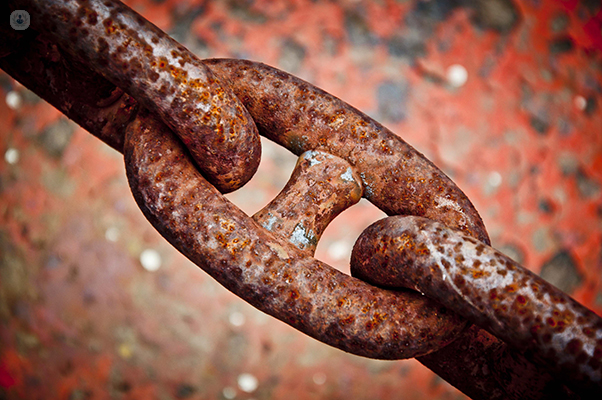Haemochromatosis
Dr Nina Salooja - Haematology
Created on: 03-12-2013
Updated on: 10-10-2023
Edited by: Sophie Kennedy
What is haemochromatosis?
Haemochromatosis is an inherited condition in which the blood has too much iron in it. Although iron is an important component of the blood, iron overload can damage the liver, pancreas, heart, and joints, among other body parts, leading to unpleasant symptoms.
Haemochromatosis most commonly affects white Europeans, particularly people of Celtic origin.

What are the symptoms of haemochromatosis?
Haemochromatosis causes iron to build up in the blood over many years. Symptoms usually start to manifest between the ages of 30 and 60. Common symptoms include:
- Constant fatigue
- Weakness
- Weight loss
- Joint pain
- Irregular or absent periods in women
- Erectile dysfunction in men
As the condition progresses, more serious symptoms can follow as effects of complications such as liver dysfunction:
- Darkening of the skin
- Jaundice
- Abdominal pain and/or swelling
- Severe joint pain
- Loss of libido
- Constant thirst and frequent urination
- Chest pain
- Shortness of breath
- Swelling in the extremities
- Arrhythmia
- Shrinking testicles in men
Causes of haemochromatosis
Haemochromatosis is caused by a faulty gene which affects the way the body absorbs iron during digestion of food. Normally, the body absorbs only what it needs, regulating the iron levels in the blood, but in haemochromatosis, the body can’t control this absorption, leading to rising iron levels over time.
The gene responsible (known as HFE) is recessive, meaning that both parents must pass the gene on for the child to be at risk of inheriting the haemochromatosis, and even then, the chances of the condition manifesting are low. It is not fully understood why.
What is the treatment for haemochromatosis?
Haemochromatosis cannot be cured, but the symptoms can be treated; that is, the amount of iron in the blood can be reduced to lower the risk of damage to the joints and organs. Treatments include:
Phlebotomy
Phlebotomy is also known as venesection, and is similar to giving blood. A needle is used to drain a small amount of blood. Red blood cells (RBCs) contain iron, so your body will use some of its excess iron to replace the removed RBCs. Patients will receive regular phlebotomies until their iron level normalises, and then less frequently afterwards to maintain a normal level.
Chelation therapy
If the patient cannot undergo phlebotomy due to fragile blood vessels, for example, medication may be used to release excess iron in the urine or faeces. Chelation therapy is not frequently recommended.
Dietary changes are not generally recommended if the patient is having one of the above treatments. However, you may be advised to avoid any sources of “extra” iron, such as supplements and “fortified” breakfast cereals.








